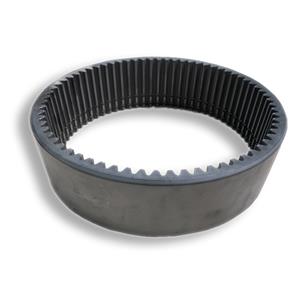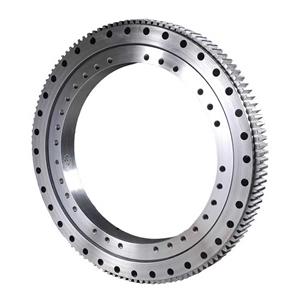What factors should be considered when selecting rolling bearings in actual use?
Rolling bearings are widely used in motor products and are standardized components with the advantages of low friction, easy starting and simple replacement. When we perform daily maintenance or engage in mechanical design, it is crucial to reasonably and correctly select bearing coordination. There are many factors that affect the selection of rolling bearings. When selecting, various factors must be considered comprehensively and combined with actual work, so as to meet the needs of actual production operations.

1. Factors to consider when selecting rolling bearings
(1)The correct selection of rolling bearings is closely related to ensuring the normal operation of the motor, extending the service life of the bearings and making full use of the bearing's load-bearing capacity. The selection of rolling bearings is mainly based on the nature and size of the load endured by the bearing ring, combined with factors such as bearing type, size, working conditions, shaft and shell materials and structures, and operating temperature.
(2)A key factor that affects the operation of the bearing is the working clearance of the bearing. The main factors that affect the working clearance of the bearing include the fit of the inner ring between the shafts and the shaft, the fit of the outer ring of the bearing and the bearing chamber, and the fit of the bearing itself under non-assembled conditions. Various objective factors such as clearance, motor operating status and turnover environment. The same motor may have different fates under different conditions of use. To ensure the guarantee effect of the bearings during the operation of the motor, we should consider the selection of bearings, determination of matching relationships, understanding of working conditions, lubrication and maintenance, etc. Make comprehensive considerations.
2. Factors that should be considered when selecting rolling bearings
(1)The problem of whether the bearing ring is rotating
When the inner ring or outer ring of the bearing is working, it is a rotating ring, and a slightly tight fit should be used. The amount of interference should be such that the mating surface does not "crawl" (customarily called running circles) under the working load, because once When crawling occurs, the mating surface will wear and slide. The higher the ferrule speed, the more serious the wear will be. When the bearing is working, if its inner ring or outer ring is a non-rotating ring, in order to facilitate disassembly, assembly and adjustment, a looser fit should be used.
Due to different operating temperature rises, the journal or housing hole will have different elongations in the longitudinal direction. Therefore, when selecting the fit, the principle is to ensure that the bearing can move freely along the axial direction and eliminate the internal stress of the support. However, if the gap is too large, it will reduce the rigidity of the entire component, cause vibration, and increase wear.
(2) Bearing load types and matching relationships
Bearing rings bear radial loads and can be divided into the following three types according to the relative motion relationship between the load and the rings.
Partial load - local load refers to the resultant radial load acting on the bearing and the ring is relatively stationary, that is, the radial load is borne by the local raceway of the ring. Cyclic load - Cyclic load refers to the combined radial load acting on the bearing and the relative rotation of the ring, that is, the radial load acts sequentially on the entire circumference of the ring raceway.
Swing load - Swing load refers to the relative swing of the synthetic radial load acting on the bearing and the ring in a certain area. The bearing bears a radial load that does not change in one direction and a rotational load. Their synthetic radial load is The fixed ferrule swings relatively within a section of the raceway.
Rings that bear local loads should choose a loose transition fit or a fit with a small gap, so that the friction torque between the ring raceways can drive the ring to rotate, so that the ring can be stressed evenly and extend the service life of the bearing. The ferrule that bears cyclic load should choose an interference fit or a tighter transition fit. The amount of interference should be such that it does not cause crawling on the mating surface of the ferrule and the shaft or housing hole. When subjected to swing loads, the matching requirements are the same as or slightly looser than those of cyclic loads.
3. Bearing load size and matching relationship
The interference of the bearing ring with the journal and housing depends on the load. Ferrules that bear impact loads or heavy loads are prone to deformation, causing uneven force on the mating surface and causing loose fit. Therefore, a tighter fit should be selected, that is, the interference amount should be larger; ferrules that bear light loads should be Choose a looser fit.
4. The influence of other factors on cooperation
Working temperature - When the bearing is working, due to the influence of frictional heating and other heat sources, the temperature of the ferrule is higher than the temperature of the matching parts. Thermal expansion of the inner ring will cause its fit with the journal to loosen, while the thermal expansion of the outer ring will cause its fit with the housing hole to become tighter. Therefore, when the operating temperature of the bearing is high, the selected fit should be adjusted appropriately.
Rotation accuracy and rotation speed - For bearings that bear large loads and require high rotation accuracy, in order to eliminate the effects of elastic deformation and vibration, fits with gaps should be avoided. For light-load bearings of some precision machine tools, in order to avoid the influence of the shape error of the shaft on the bearing accuracy, clearance fits are often used. It is generally believed that the higher the rotation speed of the bearing, the tighter the fit should be.
Conditions for installing and dismantling bearings - Considering the convenience of bearing installation and disassembly, a loose fit should be used. This is particularly important for large and extra-large bearings used in heavy machinery. If easy assembly and disassembly are required and a tight fit is required, separate bearings can be used, or bearings with a tapered hole in the inner ring, an adapter sleeve and a relief groove can be used.
The above is a detailed introduction to the factors that should be considered when selecting rolling bearings. When selecting, not only the nature and size of the load on the bearing ring must be considered, but also the type, size, working conditions of the bearing, the material and structure of the shaft and shell, and Rigid requirements such as operating temperature must also be selected based on actual usage conditions. Comprehensive considerations must be made from the selection of bearings, determination of matching relationships, understanding of working conditions, lubrication and maintenance.




